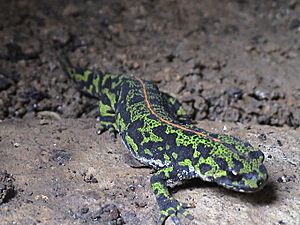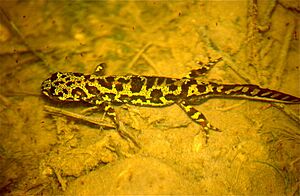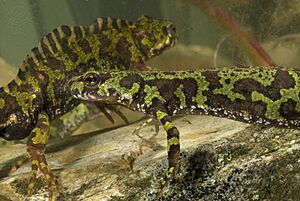Marbled newt facts for kids
Quick facts for kids Marbled newt |
|
|---|---|
 |
|
| Conservation status | |
| Scientific classification | |
| Genus: |
Triturus
|
| Species: |
marmoratus
|
 |
|
| Distribution of the marbled newt in Western Europe | |
The marbled newt (Triturus marmoratus) is a cool newt that mostly lives on land. You can find them in western Europe, especially in France and the Iberian Peninsula. They often live in mountains and hilly areas.
Contents
Where Marbled Newts Live
Marbled newts usually live in places with hills and lots of trees. They avoid open, sunny areas. These newts often make their homes in temporary ponds. These ponds can change a lot depending on the weather.
When it rains a lot and the weather is cooler, like in fall and winter, adult marbled newts stay in these ponds. But in warmer spring and summer months, these shallow ponds can dry up. This means the newts have to move onto land. Because their homes change so much, marbled newts are very good at adapting to different weather and living conditions.
The place a marbled newt lives can also affect how fast it grows up. Newts in Mediterranean areas grow up faster than those in France and Portugal. This is because the weather in Mediterranean regions can be tougher. More adult newts might die there, so growing up earlier helps them have babies sooner.
What Marbled Newts Look Like

Marbled newts have dark brown or black bodies. They have cool, irregular green patterns all over them. Their bellies are black with small, off-white spots.
Adult female newts have a bright orange stripe. This stripe runs down their back, from their head all the way to the tip of their tail. Young newts also have this stripe. But on males, the stripe fades away when they are about 9 months old.
Breeding males have a large, wavy crest. This crest goes from their neck down to the tip of their tail. It's a bit shorter where the tail meets the body. The crest is striped with yellowish-white and black colors. Adult marbled newts are usually about 5 to 6.5 inches (13 to 17 cm) long.
Marbled Newt Life and Travel
Both male and female marbled newts travel in similar ways before and after they have babies. Their spring travels are very different from their winter travels. Moving around also makes newts more likely to be eaten by predators. They can also get very dry during their travels, which is called desiccation.
Marbled newts usually start by moving only a short distance, about 10 meters (33 feet). But they have been known to travel up to 160 meters (525 feet) from their first home! They prefer to travel through areas with lots of trees and bushes. These places offer good shelter and keep them safe from open areas. Newts can also travel through open spaces if they can find underground hiding spots.
Reproduction and Life Cycle
Marbled Newt Life Cycle
The environment affects how marbled newts grow. For example, their bone density can change depending on where they live. Like some other amphibians, marbled newts grow a lot in spring and summer. Then, their growth slows down in winter. Watching these growth changes helps scientists understand how climate change affects newts.
The breeding season for newts starts in February. Their babies, called larvae, hatch in late March. The larvae change into young newts (this is called metamorphosis) from April until the end of June. The new young newts leave the water by late June at the latest. During the hottest part of summer (July-September), the ponds where they breed often dry up. This makes the newts much less active. Their activity picks up again when it starts raining in August.
Marbled newts find their breeding ponds mainly by looking at the sky. If they can't see the sky, they don't travel. When tested under cloudy skies, newts couldn't find their way. But changing the Earth's magnetic field didn't confuse them. This suggests that the magnetic field doesn't help them find their way. They might also use smells from the pond or visual landmarks to find the right spot.
Newts can also use sounds to find breeding ponds. They sometimes listen for the calls of a frog called B. calamita. Even though newts' ears are not as complex as human ears, they can still hear sounds. Sound can help them find ponds, but looking at the sky is still the most important way for them to find their breeding spots.
How Marbled Newts Choose Mates
Male marbled newts prefer larger female newts. This is because bigger females are better at laying eggs. When females lay eggs more efficiently, it means less effort and energy for the parents.
Female marbled newts are usually bigger than males. They also live longer. This, combined with reaching maturity earlier than males, means females can have more babies. Larger females are thought to produce larger offspring. These larger offspring then have a better chance of having their own babies.
Males have a special crest that females like. The height of this crest shows how healthy and fit a male is. So, males with a taller crest are more attractive to females.
During courtship, male newts perform a "tail-lashing" dance. This helps them spread their special scents, called pheromones. This dance also draws attention to the males and shows off their long tailfins. This is another trait that females look for. Males have special glands that females don't have, which produce these pheromones. This trait is only for attracting a mate and helps males have more babies.
How Marbled Newts Lay Eggs
Males don't need to be there when eggs are laid. So, females decide where and when to lay their eggs. Females prefer to lay their eggs in a different spot each time. This helps keep their babies safer.
Each egg is laid one by one. The female carefully folds each egg into an aquatic leaf using her back legs. She smells and checks the leaf before wrapping it around the egg.
Sometimes, egg-laying doesn't go perfectly. This can happen if the chosen leaf is too small or already has another egg. Folding the eggs in leaves is a way for the mother to care for her babies. The time it takes to choose and wrap each egg is a big effort from the mother. It helps protect the egg.
Laying eggs also stops the newt from breathing. So, the time spent laying eggs is very important. Sometimes, female marbled newts have to stop laying eggs to go to the surface and take a breath. Larger females are better at laying eggs because they can hold their breath longer than smaller females. This also means larger females have fewer failed attempts at laying eggs, making them more efficient at having babies.
Protecting Marbled Newts
The marbled newt is listed as "near-threatened" in France. This means they could become endangered if we don't protect them. When planning for their protection, it's important to think about the areas around ponds. These areas, called buffer zones, are important for newts when they are traveling. These wet areas help the newts complete their life cycle. It's also important to make sure there are enough good hiding places for newts during their travels. This helps protect them from predators and from drying out.
The homes of marbled newts have changed a lot recently. Many forest areas have been lost. This means their usual living spaces are shrinking, and their numbers are going down. This loss of habitat is allowing another newt, T. cristatus, to spread. This other newt likes open, flat areas.
The biggest reason for habitat loss is climate change. Changes in how land is used are the second biggest reason. Climate change directly affects the water cycle and temperature. These are two very important things for amphibians like newts. These changes can directly affect where marbled newts travel and live. Their living area has shrunk over the past few years. It is expected to shrink even more in the 21st century. While big studies have looked at the general risks of climate change and human impact, we need more local studies. These smaller studies will help us understand all the ways these changes affect marbled newts.
Marbled Newt Hybrids
T. cristatus and T. marmoratus (marbled newts) live in some of the same areas in France. This means they can sometimes have babies together, creating hybrids. T. cristatus has been spreading into more areas because climate change is breaking up the marbled newt's habitat.
Even with habitat loss, marbled newts have been good at having babies. Females live longer, so they have more years to reproduce. The eggs of both T. cristatus and T. marmoratus have similar survival rates. The hybrid newts can have even more babies than pure marbled newts. However, their eggs and embryos are less likely to survive.





